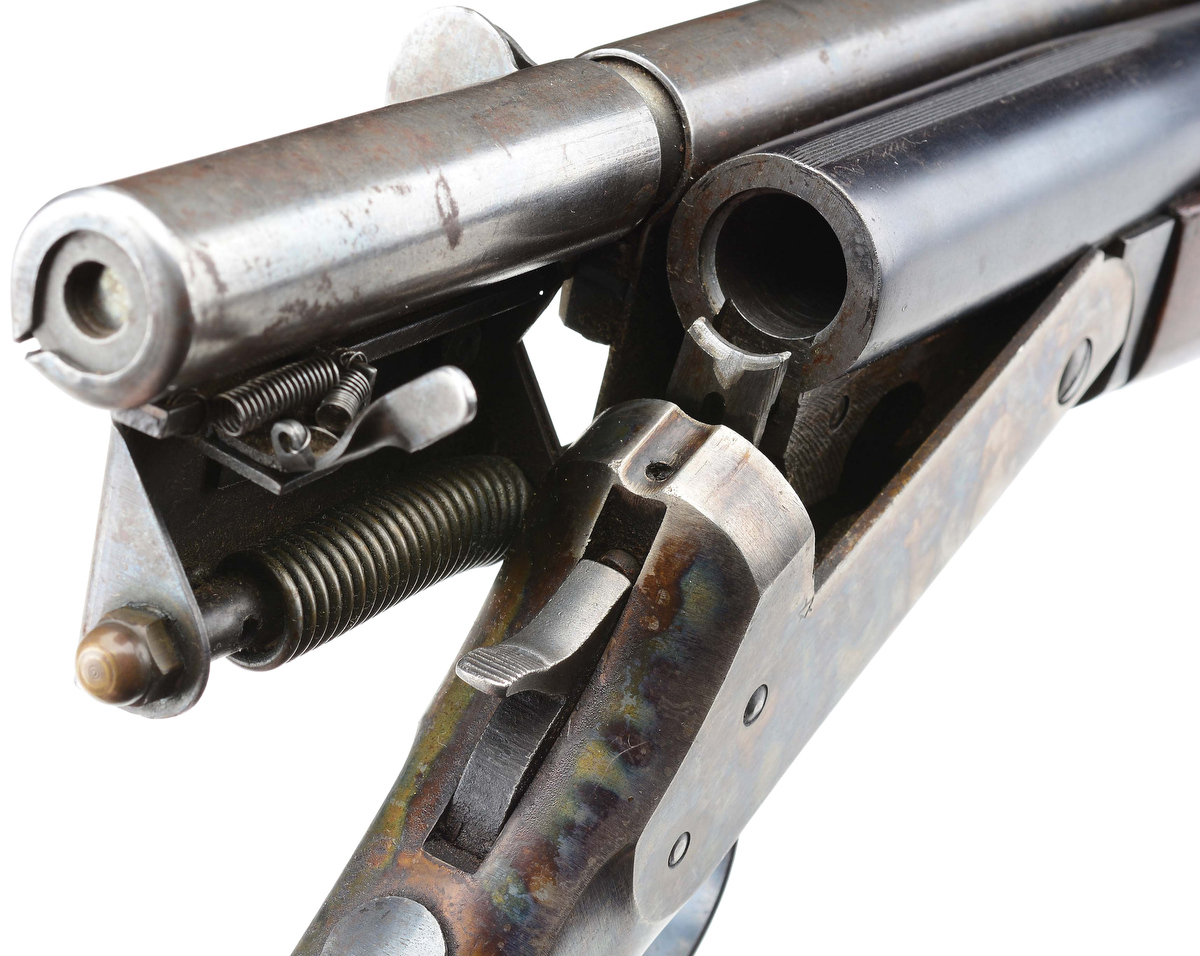Small Arms Review Editorial Staff
The following is a list of recommended Long-Range Precision Rifle training courses offered around the country. While the list doesn’t encompass all long-range precision rifle courses, the Small Arms Review staff hopes you find these suggestions useful.
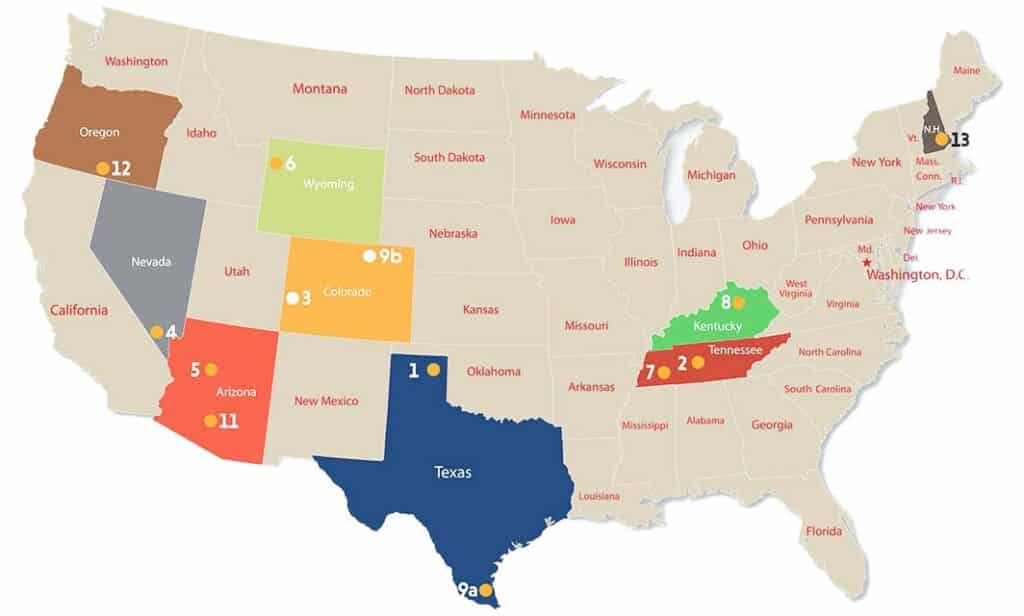
ACCURACY 1st | CANADIAN, TX
Accuracy 1st has worked with Marine Corps and SOF snipers. Training is structured to fit the needs of the client. There are two facilities—one in the panhandle of Texas and the other in the SE corner of Utah. Owner Todd Hodnett chose these two facilities for specific reasons. The Utah facility offers one of the few true high-angle shooting ranges in the nation. The Texas facility (300,000 acres) offers excellent training in a high wind environment with terrain features; wind is the primary reason we miss at long range. It also features a 1,000m, 360-degree range on one of its six ranges. Instructors are SMEs for the Horus reticle. Military courses offered include: Basic Sniper; Advanced Sniper; High Angle; Instructor Classes; Designated Marksmen; and Ballistic software training. Civilian classes are also offered.
The Introductory Long-Range 1 is a 2-day class designed for the true beginner who needs to get up to speed with all the long-range lingo and methods. Students will spend 8 hours in the classroom and 10 hours on the range learning proper fundamentals and techniques that allow the shooter more success on the range. Learn how easy it can be and not in an intimidating environment. This course is fun for everyone and very educational.
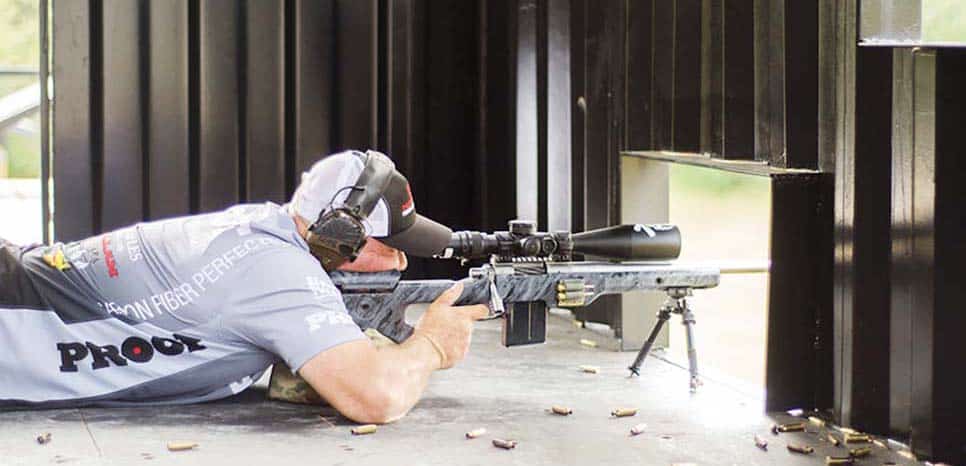
OBJECTIVES
- Learn all aspects of long-range shooting
- How to select calibers
- Reticle choices
- Understand scope manipulation, what happens when a turret is turned
- How to mount a scope
- Mils, minute of accuracy (MOA), Ballistic, BDC
- Ballistic engine explanation
- Safety
- Shooting fundamentals
- Zeroing
REQUIRED EQUIPMENT
- Rifle and scope or borrow one from Accuracy 1st
- 150-200 rounds of ammunition
- Eye and ear protection
- Sunscreen and proper clothing for hours of outside
- Note pad and pen See accuracy1st.com for more information.
BARRETT | MURFREESBORO, TN
Barrett Firearms Precision Rifle training is a commemorative teaching method using lessons learned from marksmen and snipers throughout history. Students are expected to have a high level of basic firearms knowledge, long-range marksmanship skills and abilities to make long-range precision rifle shots.
The Precision Long-Range Course provides students with additional instruction in areas Barrett assesses as crucial to students’ weapons serviceability, long-term maintenance and success as precision marksmen. When students complete this program, Barrett assures they will have a chance to make those incredible shots in history using the newfound knowledge they’ve gained in the course. Tuition includes world class range facilities / range fees, lodging, three meals each class day and exceptional instruction. Class begins at 8:00 a.m. and generally lasts until 5:30 p.m. (If planning to travel home by air on the last day, be prepared to stay in class until 5:30 p.m.)
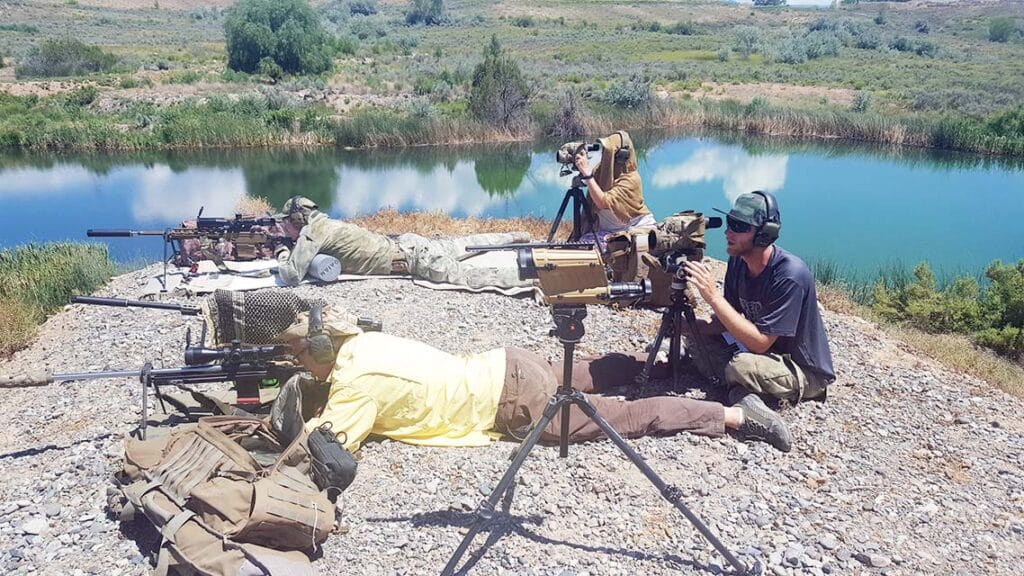
OBJECTIVES
- Range safety
- Weapons familiarization
- Care and cleaning
- Rifle set up/zeroing
- Scope theory
- Fundamentals of marksmanship
- Supported/unsupported/alternate positional shooting
- Data collection
- Effectively adjusting for wind
- Mil-relation uses / hold-over techniques
- Ammunition/ballistics
- Spotting scope techniques
- Team communication / shooter-spotter dialogue
- Live fire on unknown-distance range
REQUIRED EQUIPMENT
- Rifle capable of 1 MOA / 1,000-yard capability / with sling (Rental rifles and ammunition are available during the course for an additional fee and can be reserved during the registration process. Ammunition is included with the rental. Rental rifle fee depends on caliber; ammunition fee depends on caliber.)
- 250 rounds of ammunition (Ammunition is available for purchase when students register.)
- Tactical scope with a ranging reticle (e.g., mil-dot, TMR, Horus)
- Spotting scope w/ tripod (1 per team)
- Notebook and pencil / pen
- Calculator / phone
- Cleaning equipment (solid rod, solvent, patches, lubricant)
- Hearing and eye protection
- Drinking water
- Weather-appropriate clothing including rain gear (instructors shoot rain, shine, cold or hot)
See barrett.net for more information.
CROSSWIND PRECISION | FRULTA, CO
Long-Range Precision 1 is a 3-day course that provides in-depth training in the fundamental skills needed to successfully shoot at distances up to 1500 yards. This course walks students step-by-step through each skill, explaining both the art and science to ensure that students understand how to achieve optimal shooting accuracy and deal with adversities commonly found in the field or at matches. A team of experienced instructors are on hand to answer questions and train students to understand the mechanics of their rifles and how to properly engage with the environment in which they are shooting. This detailed process provides a solid foundation of core skills that students can continue to expand on. With plenty of range time there are challenging shooting drills. While the Long-Range Precision 1 class is only moderately physically demanding, students will move around on rough terrain and haul gear over short distances. The most physically challenging aspects of the experience tend to come from the weather, so be prepared for Colorado’s rapidly changing conditions. This course begins at 8:00 a.m. to 5:00 p.m. Thursday through Sunday. Students should have a basic understanding of firearms safety.
For those looking for sniper-specific training, Crosswind Precision offers a SniperCraft course. SniperCraft expands on the LRP1 curriculum with additional practical, real-world fieldcraft and sniper skills.
OBJECTIVES
- The principals of accuracy and fundamentals of marksmanship
- Shot group analysis
- Rifle set-up and maintenance
- Understanding and applying ballistics
- Range estimation and field sketching
- How to modify DOPE for varying environmental conditions
- How to balance speed and accuracy
- How to use a ballistic computer
REQUIRED EQUIPMENT
- High power bolt-action rifle (6mm–30 cal) or accurized semi-auto, sling and bipod. 5.56 SPR-style rifle is acceptable. Rental guns are available for an additional charge.
- Quality tactical scope with mildot or range estimation reticle and externally adjustable turrets (e.g., Nightforce ATCAR or NXS, Athlon, Vortex, Leupold Mk4, Nikon Tactical, Swarovski, Zeiss, SWFA, etc.)
- Scope must have externally adjustable turrets in order to participate in this class
- Bring owner’s manual
- Minimum 50 rounds of match-grade ammunition per day. (77 gr strongly recommended for 5.56 SPRs)
- Cleaning kit
- Rugged, comfortable clothing, suitable for all weather conditions—Crosswind Precision shoots in any and all weather
- Small “go bag” or ruck sack that will be with students at all times. Bag should have binoculars, water, snacks, elbow pads, knee pads and ammo for the task.
- A shooting or exercise mat; anything that can be rolled up and moved with students
- Ear and eye protection, sunscreen and a brimmed hat (like a boonie)
- Lunch, snack food and water
- A small calculator
- Note-taking material, including notepad, pencil and Sharpie
- Optional items: iPad or smartphone; belt magazine carriers; rifle cover (shemagh or towel); range finder; Camelback
See crosswindprecision.com for more information.
FRONT SIGHT | PAHRUMP, NV
Front Sight offers a 4-Day Precision Rifle course for those students who want to learn the skills required to make first-round hits out to and beyond 750 yards. Prerequisite classes include: Distinguished Graduate in the 4-Day Practical Rifle or 2-Day Rifle Skill Builder course AND attendance in the 1-Day Precision Rifle Fundamentals course OR have previously attended Precision Rifle. Students will NOT be able to take the course with two or more different types of ammunition. There are various age restrictions with this course.
OBJECTIVES
- Live-fire exercises designed to master the skills learned in the classroom during the Precision Rifle Fundamentals course
- Be able to make first round hits on targets out to 750+ yards, including cold bore shots
- Marksmanship, position shooting, range and wind estimation, reading mirage, hold-over estimation, dialing proper scope adjustments
- The use of data books and ballistics tables and calculators
REQUIRED EQUIPMENT
- Rifle (6.5 Creedmoor, .300 WinMag, .308 / 7.62mm, .338 Lapua or similar caliber) capable of consistently shooting LESS than 1-inch groups at 100 yards (sub-MOA)— Larger bore calibers such as .375 CheyTac, .408 CheyTac, .416 Barrett and .50 BMG and other similar calibers are not allowed
- Rifle must have mounted optics with finger-adjustable windage and elevation knobs with definite “clicks” (.25 MOA or .1 MilRad is a sufficiently fine adjustment range; students do not need any finer adjustment) and lens covers
- Bipod or pack to act as a front rest
- A small sandbag for use under the stock is recommended but not required
- A height-adjustable cheek piece, either integral to the stock or field expedient and a piece of closed cell foam—knee pad foam, section of pool “noodle”—that can be used to build up cheek piece if needed
- Match grade ammunition with the same lot number, manufacturer, bullet weight, etc.
- No armor piercing, steel jacketed, bi-metal, steel core, tracer or incendiary bullets
- Hand loads are acceptable for this class ONLY
- Eye protection
- Electronic hearing protection
- Rifle cleaning kit containing lubrication, solvents, coated cleaning rod, bore guide, toothbrush, nylon brushes, jags, patches, or VFG plugs, oil or grease, BoreSnake, etc.
- Rifle maintenance kit—All torx and /or allen head wrenches, screwdrivers, etc., specific to student’s gun, mount, rings and scope; Torque wrench is recommended for the appropriate ring, base and rifle screws
- Optics cleaning kit containing lens brush, lens paper and lens cleaning solution or “lens pen”
- Pens, pencil, notebook
- Databook
- MilDot Master or similar
- Ballistic calculator, such as Ballistic AE (Apple) or Applied Ballistics (Apple or Android)
- Rifle carrier / shooting mat combo—recommended
- All the manuals for student’s rifle, scope, etc.
- 250 rounds of Match ammunition
See frontsight.com/courses/precision-rifle-training-four-day.asp for more information.
GUNSITE ACADEMY | PAULDEN, AZ
Gunsite Academy’s Precision Rifle 7 7-day class covers all the techniques, tactics and procedures used by the sniper to get first-round hits on man-size targets out to 1,000 yards. Zeroing, data recording, ballistics and wind reading, observation and reporting methods, spotter / sniper communications, camouflage and movement techniques, moving targets and more are covered in detail.
Due to the amount of information in this course, it runs from Sunday through Saturday, which allows travel days on each end.
No bi-metal ammo can be used on steel. To check ammo, place a magnet against the bullet and if it sticks, the jacket or the core has steel in it and will damage steel targets.
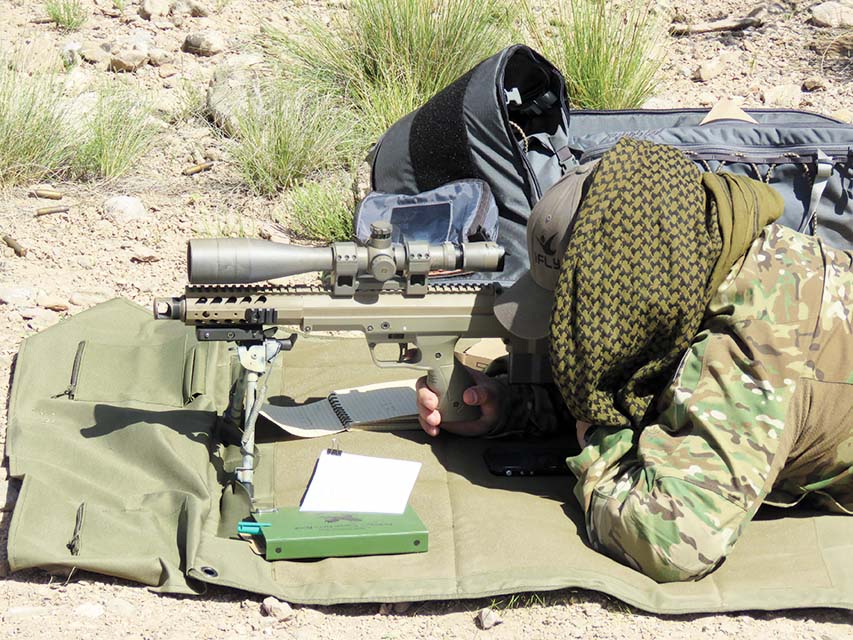
OBJECTIVE
- Students will work in sniper/observer pairs and engage more than 40 unknown distance targets from 12 different firing locations, allowing students to become truly competent in the art of “one shot, one hit.”
REQUIRED EQUIPMENT
- Serviceable rifle in .243, .308, .30-06, .270 (call about any other caliber questions)
- Ammo management gun/belt carriers
- Ear protection (rifle compatible)
- 600 rounds Match ammunition
- Telescope sight
- Cleaning equipment
- Spotting scope
- Backpack
See gunsite.com for more information.
JACKSON HOLE SHOOTING EXPERIENCE | JACKSON HOLE, WY
Jackson Hole Shooting Experience aims to help shooters improve their skills with premium private instruction, whether beginner, intermediate or advanced. Long-range precision rifle instructors can be hired with a 4-hour minimum in Jackson Hole, Wyoming. Included in the Jackson Hole session can be several scoped .22 and .223 rifles, scoped long-range rifles in .308 Winchester, 6.5 Creedmoor, 7mm Rem Mag and a 300WM. Classes range from 4 hours to a customized, turnkey 1-week experience that includes transportation and 5-Star lodging. Senior Lead instructors include Shep-ard Humphries and Scott Austin. Students may use their own firearms, safety equipment and ammunition or use the company’s. Staff provides cold water, snacks, range fees, targets, range setup and cleanup as well as private instruction. Experiences can be arranged in many western states. When instructors help plan students’ customized training, they can hone in on equipment needs. This firm caters to successful executives who seek the “best of the best” for their clients and families. This company does not manufacture or sell firearms or accessories; it prides itself on being objective and focusing on instruction.
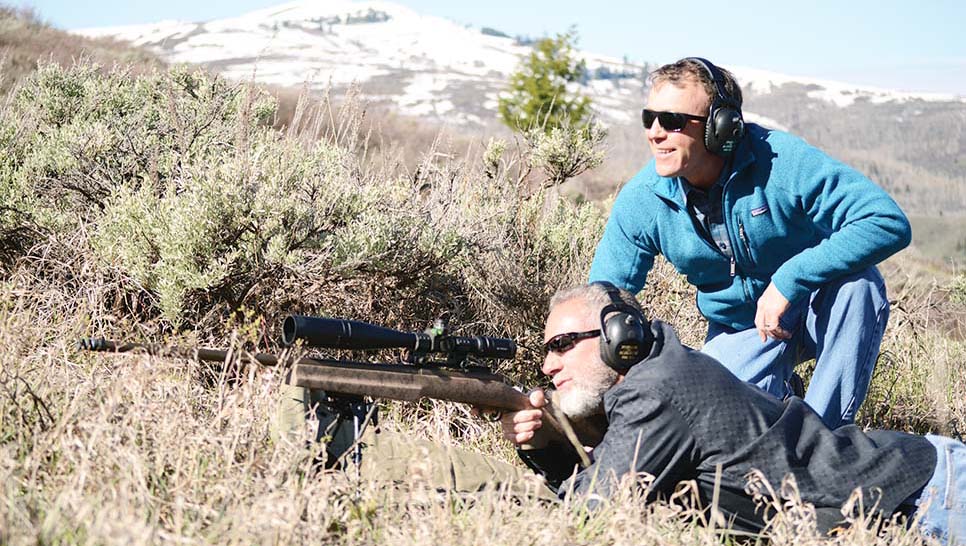
OBJECTIVES
- Provide a supervised, safe and encouraging environment for individuals, families and small corporate groups.
- Experiences are available that focus on experiential learning, with a focus on friends honing skills while plinking at a mile, or the focus can be on learning complex details.
- Private, professional instructors help shooters improve their skills whether students are beginner, intermediate or advanced.
REQUIRED EQUIPMENT
- Some guests do not bring any equipment and use the company’s gear and equipment. All experiences and training are customized and private.
- Long-range rifle capable of 1 MOA or smaller groups and ability to stay super-sonic beyond 1,200 yards, or use the company’s loaners
- Optional extreme long-range gun for shots 1,200 to 2,500+ yards, or use loaners
- Firearms must have quality glass capable of large adjustments, or use loaners
- Ammunition, or use ours
- Bipod, shooting sticks, rear squeeze bags and other gear to build positions
- Comfortable shooting clothing; Wyoming weather changes rapidly
- Weather-prepper clothing, i.e., rain gear, wool underwear, gloves, etc.
- Sunglasses and clear shooting glasses or use loaners
- Electronic hearing protection or use loaners Quality range-finder capable of up to 2,000 yard reads or use loaners
- Kestrel wind reader or use loaners
- Ballistics program or DOPE sheet and/or develop this with our friendly, fun and patient tutelage
See shootinjh.com for more information and check references on Trip Advisor.
K&M PRECISION RIFLE TRAINING | FINGER, TN
K&M offers a variety of precision rifle courses, from basic to competitive to advanced. Information for the basic course is provided here.
The basic course is a 2-day course designed for the novice marksman, but it is highly encouraged and recommended for those who have had little or no formal training to attend. A fast-paced course, it will begin with firearms safety and rapidly transition into equipment comprehension, fundamentals of marksmanship, basic ballistics, wind reading, range estimation, mover targets and target engagements to 1,000 yards. This course will use the entire K&M Shooting Complex, fully taking advantage of the 12-plus ranges onsite. Students who complete the course will have a basic proficiency in firearm safety, marksmanship fundamentals, a combined knowledge of their personal capabilities with their equipment and systematic training methods for future progression.
Class sizes are limited to maintain a proper instructor to student ratio. A K&M student course material/data entry book is included with each course. Custom GA Precision rifles with Kahles 6-24x56i scopes (w / K&M’s / Shannon’s SKMR 3 reticles) are available for rental. Quantities are limited, so please purchase when registering. A sling, rear bag and bipod are included in house gun rental. Match ammunition is also available for purchase when renting a house gun. Bunk House accommodations are included at no additional cost to provide an enhanced learning experience.
OBJECTIVES
- Safety
- Equipment selection and care
- Building position, basic fundamentals of marksmanship, trigger control, recoil management
- Introduction to wind reading
- Employing the milliradian reticule for range estimation
- Understanding MOA and milliradian adjustments
- Introduction to internal and external ballistics
- Introduction to positional shooting–prone, kneeling, sitting
- Data gathering out to 1,000 yards
- Engagement of moving targets
- All classes start at 8 a.m. CST
REQUIRED EQUIPMENT
- 308, 6.5mm, 6mm or similar caliber precision rifle capable of 1 MOA
- Match ammunition (minimum 100- 125 rounds per day)
- Quality scope with adjustable turrets and MIL or MOA reticle
- Bipod
- Sling
- Rear bag
- Cleaning kit
- Pen, pencil, highlighter
- Rifle data book or notebook
- Calculator
- Eye and ear protection
- Comfortable yet durable clothing (pants and long sleeved shirt recommended)
- Durable footwear
- Water
- Food / Lunch to snack on throughout the day
- Backpack
- Shooting mat (if desired)
- Sunscreen / bug repellent
See kmprecisionrifletraining.com for more information.
MAGPUL CORE | ROCKCASTLE, KY
The Long-Range Precision 1 is a 3-day course for those looking for an in-depth introduction to the basics of long-range shooting. This course debunks all the myths by focusing on both the science and the art of the discipline. By taking a systematic approach to the fundamentals of marksmanship and the mechanics of student equipment, shooters will build a solid foundation of core skills that they can continue to expand on. Students will be able to gauge their progression every day through purpose-built shooting drills that reinforce key topics. The course is helpful to those new to long-range shooting and to those looking for a refresher. There are no prerequisites, but students will be expected to possess a basic understanding of firearms safety and a willingness to learn.
OBJECTIVES
- Rifle manipulation and maintenance
- Optic manipulation (focus/parallax adjustment, zeroing)
- The fundamentals of marksmanship
- Basic internal ballistics
- External ballistics and ballistic software
- How to estimate and read wind
- Range acquisition, estimation and angular units of measure
- Known distance and unknown distance shooting
- Introduction to unconventional shooting positions
- Introduction to stress shooting
REQUIRED EQUIPMENT
- A rifle that is capable of at least printing a 1 MOA (1 inch) group at 100 meters/yards
- 400 rounds of Match ammunition (See the ammunition and reloading policy page for details.)
- A magnified optic that has exposed target-style turrets, a range-finding reticle and is mounted to the rifle with quality equipment—Instructions on the optics’ reticle and mechanics are beneficial, as well as the proper tools associated with adjusting the optic
- Bipod (preferably with the ability to adjust and lock the left / right cant of the rifle)
- Rear shooting support, also known as a “rear bag”
- A rifle sling with the ability to mount the sling to the rifle
- Backpack or bag to carry range equipment
- Note taking material, to include fine-point colored Sharpie permanent markers
- Appropriate clothing for the weather— Magpul Core shoots in any and all weather conditions
- Hydrating device along with plenty of water
- Lunch for all training days
See magpulcore.com/courses/precision-rifle for more information.
RIFLES ONLY | a. KINGSVILLE, TX b. FORT COLLINS, CO
Rifles Only offers various courses. Their signature course is the Precision Rifle I & II Combo course, which is good for any level of shooter. This course focuses on safety, fundamentals of marksmanship, recoil management, positional shooting, movers, trajectory and wind compensation, use and difference between cover and concealment, care of the precision rifle and optics and more.
For the advanced marksman, there is the High Angle Precision Rifle Training course offered in Colorado. This course spans 4 days, with 400-round count and is open to civilians, military, law enforcement and private security contractors. Students will spend the majority of the time angle-long-distance shooting. This class will be heavy on fundamentals, positional, platform building and alternate positions. This course takes place on three mountain ranches west of Fort Collins, Colorado.
OBJECTIVES
- Alternate position shooting
- Alternate support
- Fundamentals of marksmanship
- Gear selection
- Milliradian system for range estimation
- Safety
- Sling use
- Target detection
- Trajectory & wind compensation
REQUIRED EQUIPMENT
- Precision rifle capable of 1 MOA (no larger than .30 caliber)
- 308 rifle or other short action caliber capable of 1 MOA (recommended)
- Ammunition
- Bipod
- Calculator and 2 small spiral notebooks or one rifle data book / pen, pencil, highlighter
- Cleaning equipment for all firearms
- Easily adjustable scope
- Eye and ear protection
- Hat or ball cap
- Leather or nylon precision rifle sling (not a carry strap)
- Long sleeved shirts and long pants
- Rear bag
- Rucksack or backpack to carry all gear
- Scope
- Leather or Nylon precision rifle sling
See riflesonly.com for more information.
STEVE REICHERT TRAINING
This Precision Rifle Course is an intense 2-day course that focuses on the skills required to become proficient at engaging distant targets under field conditions. Basic rifle marksmanship fundamentals are the core of the course. Very little time will be spent in the prone position. Students will be on their feet 10+ hours a day. Be prepared both physically and mentally.
OBJECTIVES
- Learn basic rifle marksmanship fundamentals
REQUIRED EQUIPMENT
- Scoped rifle (bolt or semi) capable of 1 MOA
- 400 rounds of Match Grade ammunition
- Data book
- Eye and hearing protection
- Tripod
- Handheld flashlight
- Sling
- Cleaning equipment
- Sunblock
- Ball cap
- Appropriate clothing for the weather
- Multi-tool
- Spotting scope
- Shooting mat
- Bipod or small rest
- Backpack to carry all daily gear in
- Scope cover or caps
- Snacks as required and a means of hydration
- First aid kit
- PDA or Smartphone with ballistic software
See stevereicherttraining.com for more information.
SURGEON RIFLES | PHOENIX, AZ
The Precision Course is an intermediate training course and builds upon the foundation from the basic training course. Students will learn advanced wind reading, while engaging targets at long range. Day 1 is spent refreshing the basics and fine-tuning the students’ fundamentals. Classroom curriculum covers using hold-offs, advanced wind reading, use of ballistic computers and wind reading devices. Students learn quick formulas to convert wind readings into wind holds and increase their likelihood of 1st-round hits at longer distances. Day 2 is spent learning and testing lessons learned on wind reading. Students will spend hours reading wind and testing formulas while engaging targets at long range with a focus on mastering wind reading. By the end of Day 2, students should be able to read wind direction and have a working knowledge of identifiers that dictate wind speed and how to convert that for appropriate use and consistent hits. Day 2 has a night fire phase, which demonstrates the use of night vision optics lasers, infrared flood systems and thermals. Students will engage targets out to 800 yards in total darkness. Day 3 covers field shooting, alternate shooting techniques and extreme long-range shooting. Instructors will
work with students to ensure they maximize the effective range of their rifle systems. Completion of the 2-day marksmanship course is a prerequisite for this course. Courses may be taken consecutively as one 5-day course.
Onsite lodging is available for $50/day. This facility is at the range where the training courses are conducted. This housing is “bunk-house-style” and will be shared rooms. Provisions should be brought to the facility if using this option.
OBJECTIVES
- Ranging and engaging targets
- Alternate shooting positions
- Multiple target engagements
- Thermal device shooting
- Advanced wind reading
- Sniper/observer team training
- Speed formulas and application
- Hold-off / hold-overs / hold-unders
- Use of ballistic computers
- Night vision shooting
REQUIRED EQUIPMENT
- Modern bolt-action precision rifles chambered .337 and below
- A list of other required items will be provided once students register for the course.
See surgeonrifles.com for more information.
THUNDER RANCH | LAKEVIEW, OR
Thunder Ranch offers an Urban Precision Rifle (UPR) course. UPR is a fusion of Urban Rifle and Precision Rifle. While keeping the rifle platform of Urban Rifle, it holds to a higher standard and responsibility of impacts. It takes the shooter from applying marksmanship from pristine range positions to field-expedient and practical applications through realistic building facades and cover on the move. All shooting is precision shooting, but sometimes that shooting needs to be surgical. This course covers that. Drills will include safety, movement, cover, moving targets, hostage-type targets, firing from elevated platforms and reactive targets.
OBJECTIVES
- Students will see the true capability of their rifle and scope combination
- Students will be introduced to team spotting and giving corrections and calls for their partner
- Students will learn field-expedient and practical applications through realistic building facades
REQUIRED EQUIPMENT
- Low-powered scopes or dot optics with magnifiers acceptable
- Nominal 800–1,000 rounds of ammunition
- Bolt guns welcome
See thunderranchinc.com for more information.
SIG SAUER ACADEMY | EPPING, NH
The Precision Scoped Rifle course is designed for the responsible citizen as well as the armed professional who wants to learn the proper use and handling of the precision scoped rifle and associated equipment.
Instruction begins in the classroom with an understanding of equipment selection and setup, followed by ammunition selection and internal, external and terminal ballistics review. Range instruction focuses on fundamental marksmanship skills including alternative shooting positions, zeroing a rifle, grouping and scope tracking. Live-fire exercises and function drills are designed to test the soundness of the rifle/optic combo in field conditions, and students will practice engaging paper and steel targets out to 300 yards using a mix of improvised positions. The course concludes with a preventative maintenance and equipment care session.
OBJECTIVES
- Responsible firearms ownership and applications of the precision hunting rifle
- Firearms safety that works—in the home, workplace, vehicle, in training and in carry
- Selection of a precision scoped rifle system and accessories
- Selection of ammunition
- Rifle ballistics—interior, exterior and terminal
- Administrative handling and operation
- Foundational shooting techniques—scoped rifle fundamentals
- Carry conditions and uses of the sling
- Zeroing and grouping at various distances
- Precision shooting drills
- Improvised shooting positions
- Field shooting exercises to 300 yards
- Preventative maintenance session—cleaning, maintenance, inspection and safe storage
REQUIRED EQUIPMENT
- Precision scoped rifle with sling
- Spotting scope (optional)
- Rangefinder (optional)
- Rifle cleaning equipment
- Field notebook and pencils
- Clothing suitable for training in any weather
- Hydration system
- Sunscreen and bug spray
- Hat with a brim
- Wraparound eyewear, polycarbonate lenses or non-shattering prescription glasses
- Earmuffs and earplugs
See sigsaueracademy.com for more information.
| This article first appeared in Small Arms Review V24N3 (March 2020) |






